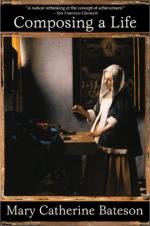|
This section contains 496 words (approx. 2 pages at 400 words per page) |

|
Composing a Life Summary & Study Guide Description
Composing a Life Summary & Study Guide includes comprehensive information and analysis to help you understand the book. This study guide contains the following sections:
This detailed literature summary also contains Topics for Discussion and a Free Quiz on Composing a Life by Mary Catherine Bateson.
Composing a Life is a non-fiction book written in the first-person narrative by Mary Catherine Bateson. In this book, Ms. Bateson takes an artistic approach to achievement. She looks closely at the lives of four of her successful friends and her own life and finds commonalities in how they all have composed very successful lives in spite of numerous discontinuities along the way.
None of the five women in the book have followed a straight path to success. Much of their decisions have been in response to situations and individual needs. They have learned to thrive even when being pulled in many different directions. All of the women have learned to have a high degree of flexibility and they have also learned to be comfortable living in ambiguity. Rather than setting a single goal and moving toward it, they pick up disparate pieces and respond to circumstances, and that allows them to compose a unique and beautiful life.
The five women who are central to the book are Mary Catherine Bateson, a writer, anthropologist, professor, dean, and researcher; Johnnetta Cole, the president of Spelman College, anthropologist, educator, and activist; Joan Erikson, a dancer, writer, and jewelry designer; Alice d'Entremont, an electrical engineer and entrepreneur; and Ellen Bassuk, a psychiatrist and researcher. They span a variety of ages and multiple professional fields, but they share many common themes in the way they compose their lives.
Mary Catherine Bateson uses two central metaphors throughout the book. The first is a music metaphor. Creating a life is like improvisational jazz. One takes bits and pieces of familiar music and rearranges them into a unique new masterpiece. The second metaphor that is prevalent in the book is that of creating a quilt or weaving, where different pieces or threads are cut to fit together and then sewn or woven into a beautiful whole.
Each chapter in Composing a Life centers on a common theme that comes up in conversations with the five women, from care-taking to partnerships to dealing with disillusionment and distrust. The book begins with individual stories of women struggling to create a meaningful life that enriches the world around them. It ends with a call to action for men and women everywhere. In the final chapter, Enriching the Earth, Mary Catherine Bateson makes a plea to everyone to think more globally and instead of competing with one another, more toward creative interdependence. All forms of life need to be nurtured if we are to survive as a whole.
There has been some criticism that this book is not as clearly focused as some of Mary Catherine Bateson's other writing, but that may have been her intent. The book is pieced together just like the quilt she uses so prominently as a metaphor. Various bits of conversations and scraps of research weave together throughout the pages to create a strong whole that suggests multiplicity, flexibility, and care-taking as paths to composing a fulfilling life.
Read more from the Study Guide
|
This section contains 496 words (approx. 2 pages at 400 words per page) |

|



